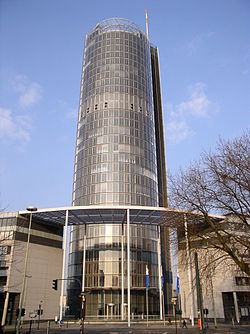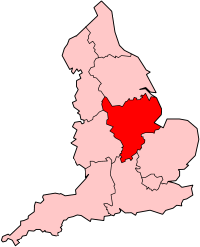Triton Knoll
| Triton Knoll Wind Farm | |
|---|---|
 | |
| Country | England, United Kingdom |
| Location | North Sea |
| Coordinates | 53°24′N 0°54′E / 53.4°N 0.9°E |
| Status | Under construction |
| Commission date |
|
| Owner | Innogy |
| Wind farm | |
| Type | Offshore |
| Distance from shore | 33 km (20.5 mi) |
| Power generation | |
| Units operational | 90 × 9.5 MW |
| Make and model | 90 x MHI Vestas v164 9.5 MW |
| Nameplate capacity | 857 MW |
| External links | |
| Website | www |
Triton Knoll Wind Farm is a consented round 2 offshore wind farm 33 kilometres (21 mi) off the coast of Lincolnshire, in the North Sea, England.
RWE Npower Renewables (now: Innogy) were awarded the lease to the development area in 2003. The offshore elements of the wind farm of up to 1200MW power gained planning consent in 2013; RWE reduced the scope of the wind farm to 900MW or under in 2014, to reduce cost per MW.
Statkraft became joint owner of the development in early 2015. The onshore and offshore electrical connection assets were given planning permission in September 2016. The Project is now owned by Innogy (59%), J-Power (24%) and Kansai Electric Power (16%).
History
The project was initially developed by RWE Npower Renewables, who was awarded the 'Triton Knoll' development area by the Crown Estate in 2003.[1] The original 206.9 square kilometres (79.9 sq mi) development was refined, extending north outside the original area, with the boundaries of the area defined by the avoidance of main shipping routes.[2]
In 2008 the developer accepted an offer from National Grid for an onshore grid connection at Bicker Fen, with landfall made at Mumby. Later the connection offer was withdrawn by National Grid due to a re-assessment of their planning. By 2011 the two parties had agreed on a connection at Bicker Fen.[3] However, due to uncertainty over the final state of the Bicker Fen substation, in 2011 the developer split the planning applications into separate offshore wind farm and electrical system applications, to minimise delay.[4]
A planning application for the offshore elements was submitted in early 2012.[5] The formal developer was Triton Knoll Offshore Wind Farm Ltd, a 100% subsidiary of RWE Npower Renewables -they applied for a wind farm of 135 square kilometres (52 sq mi) in size off the North Norfolk and Lincolnshire coast in the southern North Sea; the development area was cut in two by a NE/SW running pipeline channel of 500 metres (1,600 ft) width.[6] The proposed wind farm would be of up to 1200MW capacity, with turbines foundations in water with depth of 18 to 24 metres (59 to 79 ft). The planning application included the offshore structures, but excluded the undersea export cable, and onshore electrical infrastructure.[7]
In July 2013 the government approved the plan for a wind farm of up to 288 turbines with up to 1200MW generating capacity, with associated meteorological masts, offshore substations,[note 1] and connecting cabling, with wind turbines limited to 220 metres (720 ft) tip height, 140 metres (460 ft) rotor height, and 180 metres (590 ft) rotor diameter. Additionally pile driving was not permitted during the Herring spawning season (September to mid October), without prior permission.[5][8][9]
In January 2014 the developer RWE announced that it had chosen to progress with a reduced plan of between 600 and 900 MW power, in order to reduce the cost (per MW) of the development.[10]
In February 2015 Statkraft acquired a 50% stake in the project.[11] In late 2015 Statkraft announced it would no longer be investing in offshore wind, but would continue with the development at Triton Knoll.[12]
In April 2015 the developers submitted their planning application for the electrical power export system.[13] HVAC was identified as the preferred method of electrical power export; HVDC and mixed HVDC/HVAC systems were considered but HVDC was rejected primarily on cost grounds, with the export cable length not sufficiently long to justify a HVDC system.[14] Overhead lines were rejected on environmental impact grounds.[15] A landfall at or near Anderby Creek was identified as likely,[16] An intermediate electric compound (IEC) use to regulate the reactive power of the AC cables, and a preferred site was selected to the west of Skegness Stadium.[17][note 2] A final substation site at or near Double Twelve Groves northwest of the Bicker Fen connection, and adjacent east of the South Forty Drain was shortlisted as the preferred option.[19] Offshore and onshore export cables were to be energised at up to 220kV for a connection at Bicker Fen at 400kV.[20]
The proposed onshore cable route consisted of around 63 kilometres (39 mi) of underground cable - a number of interested parties raised concerns about the cable route and windfarm: farmers and the NFU raised concerns about its affects on drainage;[21] and Lincoln City Council claimed the development would have a negative affect of tourism;[22] Lincolnshire County Council raised concerns about the combined environmental impact of the onshore link together with the Viking Link electrical connector to Denmark.[23]
The electrical grid connection including onshore and offshore cabling was given planning permission in September 2016.[24][25]
If constructed the wind farm is estimated (2015) to represent a total investment of £3-4 billion.[26]
Construction
Initial onshore construction started in 2018, with main construction of the substation and cable route planned for late summer 2018.[27] Construction of the cable route commenced in September 2018, with work on the substation set to start in early 2019.[28][29] Offshore construction began in January 2020, with first foundation installed on 22 January 2020 by the Seaway 7’s Strashnov vessel.[30]
Notes
- ^ In the original wind farm planning consent, & The Triton Knoll Offshore Wind Farm Order 2013, explicit reference is made to the use of HVDC substations without any mention of HVAC technology, whilst in the electrical system planning application, Electrical System. Site selection 2015, §2, the developers explicitly state that HVAC was the chosen technology
- ^ The original site of choice was deselected in early 2014 following an objection from East Linsey District Council due to a clash with the local development plan Vision for Skegness.[18]
References
- ^ ES Non technical summary 2012, §5.2.
- ^ ES Site selection 2012, §3.29-3,31; Fig.3.4.
- ^ ES Site selection 2012, §3.33-3.42.
- ^ Electrical System. Site selection 2015, §1.2.1.
- ^ a b Triton Knoll Offshore Wind Farm given development consent (press release), Planning Inspectorate, 11 July 2013
- ^ ES Non technical summary 2012, §1.2; Fig.1, p.2.
- ^ ES Non technical summary 2012, §3.1-3.2.
- ^ "Triton Knoll wind farm gets green light", BBC News, 11 July 2013
- ^ The Triton Knoll Offshore Wind Farm Order 2013, Schedule 1. Parts 1-3, pp.6-8; Schedule 2. Part 2, §16, p.26.
- ^ "RWE cuts UK offshore wind farm capacity by up to half", www.reuters.com, 6 January 2014
- ^ Sources:
- Triton Knoll offshore wind farm deal announced, Grimsby Telegraph, 13 February 2015
- RWE Innogy and Statkraft agree partnership deal for Triton Knoll Offshore Wind Farm (press release), RWE Innogy, 13 February 2015
- ^ Laister, David (16 December 2015), "Triton Knoll still on as Statkraft says 'no more' to offshore wind", Grimsby Telegraph
- ^ Triton Knoll Electrical (planning) 2015.
- ^ Electrical System. Site selection 2015, §2.1.
- ^ Electrical System. Site selection 2015, §2.1.6, 2.3.3.
- ^ Electrical System. Site selection 2015, §3.1.1-3.1.2.
- ^ Electrical System. Site selection 2015, §5.
- ^ "Onshore rethink for Triton Knoll", renews.biz, 29 January 2014
- ^ Electrical System. Site selection 2015, §7.
- ^ Electrical System. Planning statement 2015, §2; Fig. 3-1, p.9.
- ^ Sources:
- "Lincolnshire farmers concerned about controversial Triton Knoll wind farm cable plans", www.lincolnshireecho.co.uk, 3 November 2013
- "Lincs wind farm project will damage land, warns NFU", www.fwi.co.u, 8 November 2015
- ^ "Lincoln County Council's serious concerns over Triton Knoll", www.itv.com, 6 November 2015
- ^ "Fight against Triton Knoll onshore development continues", www.lincolnshire.gov.uk, 6 October 2015
- ^ "Green light for Triton grid", renews.biz, 6 September 2016
- ^ "Triton Knoll Electrical System given development consent - GOV.UK". www.gov.uk. Retrieved 5 June 2017.
- ^ Cho Walsgard, Jonas (13 February 2015), Statkraft Buys Stake in U.K. Triton Knoll Wind Farm Development
- ^ "Archived copy". Archived from the original on 11 August 2018. Retrieved 10 August 2018.
{{cite web}}: CS1 maint: archived copy as title (link) - ^ https://www.offshorewind.biz/2018/09/10/triton-knoll-onshore-works-start/
- ^ http://www.tritonknoll.co.uk/triton-knoll-officially-starts-onshore-construction/
- ^ "Seaway 7 installs first turbine foundation at Triton Knoll Wind Farm". Power Technology | Energy News and Market Analysis. 22 January 2020. Retrieved 28 January 2020.
Sources
- Triton Knoll Offshore Wind Farm (planning documents), National Infrastructure planning, 2012
- Environmental Statement. Non-technical summary (PDF), January 2012
- Environmental Statement. Volume 1: Chapter 3 – Site Selection and Consideration of Alternative (PDF), January 2012
- The Triton Knoll Offshore Wind Farm Order 2013 (PDF) (Statutory Instruments), 11 July 2013
- Triton Knoll Electrical System (planning documents), National Infrastructure planning, 2015
- Site Selection and Design Report Part 1 - Report and Appendices A and B (PDF), April 2015
- Planning Statement (PDF), April 2015
External links
- "Triton Knoll", www.rwe.com (developer webpage)




